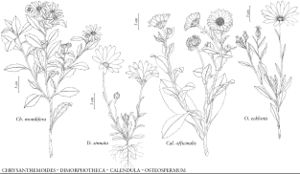Difference between revisions of "Chrysanthemoides monilifera"
Stud. Calenduleae, 374. 1943.
IntroducedIllustrated
Basionym: Osteospermum moniliferum Linnaeus Sp. Pl. 2: 923. 1753
Treatment appears in FNA Volume 19. Treatment on page 380.
imported>Volume Importer |
imported>Volume Importer |
||
| Line 61: | Line 61: | ||
|publication year=1943 | |publication year=1943 | ||
|special status=Introduced;Illustrated | |special status=Introduced;Illustrated | ||
| − | |source xml=https:// | + | |source xml=https://bitbucket.org/aafc-mbb/fna-data-curation/src/2e0870ddd59836b60bcf96646a41e87ea5a5943a/coarse_grained_fna_xml/V19-20-21/V19_614.xml |
|tribe=Asteraceae tribe Calenduleae | |tribe=Asteraceae tribe Calenduleae | ||
|genus=Chrysanthemoides | |genus=Chrysanthemoides | ||
Latest revision as of 20:53, 5 November 2020
Leaf blades 20–70+ × 8–25(–45+) mm, ± coriaceous. Peduncles 1–3 cm. Involucres 3–5 × 9–12 mm. Ray corolla laminae 5–15+ mm. Disc corollas 3–4 mm. Cypselae 4–7 mm. 2n = 20.
Phenology: Flowering Apr.
Habitat: Disturbed places
Elevation: 0–200 m
Distribution

Introduced; Calif., Africa, introduced elsewhere.
Discussion
Chrysanthemoides monilifera is cultivated and rarely escapes and/or persists in the flora. It is reputed to be a pest in Australia and New Zealand.
Selected References
None.
Lower Taxa
None.
